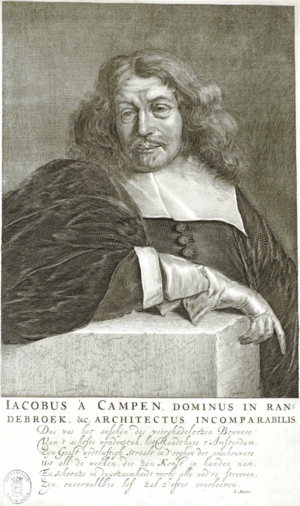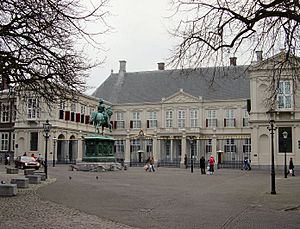Jacob van Campen facts for kids

Jacob van Campen (born February 2, 1596 – died September 13, 1657) was a very important Dutch artist and architect. He lived during the Dutch Golden Age, a time when the Netherlands was very rich and famous for its art and science.
Contents
Life of Jacob van Campen
Jacob van Campen was born into a rich family in Haarlem. He spent his younger years in his hometown. Because he came from a well-off family and had free time, he started painting as a hobby.
Early Career and Italian Influence
In 1614, Jacob became a member of the Guild of Saint Luke. This was a special group for artists and architects in Haarlem. He studied painting with a teacher named Frans de Grebber. Some of Jacob van Campen's paintings can still be seen today.
From about 1616 to 1624, he probably lived in Italy. While there, he learned a lot about old Roman and Greek architecture. He was inspired by famous Italian architects like Andrea Palladio and Vincenzo Scamozzi.
Developing a New Style
When Jacob van Campen came back to the Netherlands, he focused on architecture. He used the ideas he learned in Italy, especially from Vitruvius, an ancient Roman architect. He mixed these classical ideas with the traditional Dutch brick style.
This new way of building was called "Dutch Classicism". It was a very important style that influenced buildings not just in the Netherlands but in other countries too. It brought a classical look to Dutch Baroque architecture.
Friendships and Early Works
Jacob van Campen was good friends with Constantijn Huygens, a famous Dutch poet and composer. Together, they designed a new house for Huygens. Even after Van Campen died, his ideas continued to inspire other designers, like those who planned the gardens in Kleve and the city palace in Potsdam.
One of Van Campen's first known buildings was the Coymans house in Amsterdam, built in 1625. In the 1630s, he worked with Pieter Post to design the Mauritshuis in The Hague. This beautiful palace is now a famous art museum. Van Campen also designed the first theater in the Netherlands, the Stadsschouwburg in Amsterdam.
Later Projects and Challenges
Around 1645, Van Campen designed the Nieuwe Kerk (New Church) in Haarlem. This church's design later influenced Christopher Wren, a famous architect in England. His most well-known work is probably the large Town Hall of Amsterdam, which started being built in 1648. Today, this building is known as the Royal Palace in Dam Square.
Jacob van Campen was not only an architect but also a painter and a designer of decorations. For example, he designed parts of the church organ in Alkmaar. Many other artists helped him with his projects, including Pieter Post and Artus Quellinus.
During the building of the Amsterdam Town Hall, Van Campen lived in expensive rooms. In 1654, he had an argument with Willem de Keyser and left the project. Another architect, Daniël Stalpaert, took over. Some people thought Stalpaert's finishing touches were not as good as Van Campen's original plans.
Final Years
After a long and successful career, Jacob van Campen died in 1657. He passed away at his country home called Randenbroek near Amersfoort. He had inherited this home from his mother and had made it even bigger and more beautiful. He never married, but he had one son named Alexander Van Campen.
Famous Designs
Jacob van Campen was very careful about which projects he took on. Here are some of his most famous works:
- The Royal Palace in Amsterdam: This building was originally the city hall. Van Campen started designing it in 1647. It was meant to be a perfect building, showing power through its simple, balanced design. Some people thought the entrance was too plain because it didn't have grand stairs.
- The Mauritshuis in The Hague: Designed in 1633, this beautiful palace is now home to a famous art gallery.
- The Theatre of Van Campen in Amsterdam: Built in 1638, this was the first theater in the Netherlands. It was inspired by the famous Teatro Olimpico in Italy.
- The Paleis Noordeinde in The Hague: This royal palace was designed around 1640.
Besides houses and palaces, he also designed several churches. These include churches in Renswoude and Hooge Zwaluwe, and the Nieuwe Kerk in Haarlem. The Nieuwe Kerk was so impressive that a painter named Pieter Saenredam made many paintings and drawings of it. Van Campen also designed gates and towers for churches like the Westerkerk and Nieuwe Kerk in Amsterdam. His paintings and wall decorations, like those at Paleis Huis ten Bosch, show a style similar to other Dutch painters of his time.
|
See also
 In Spanish: Jacob van Campen para niños
In Spanish: Jacob van Campen para niños




